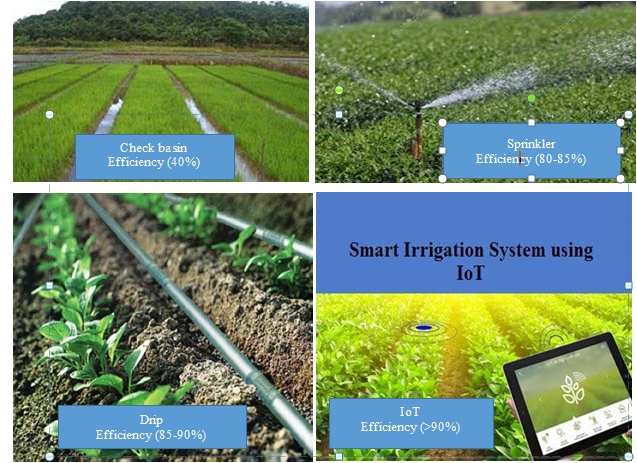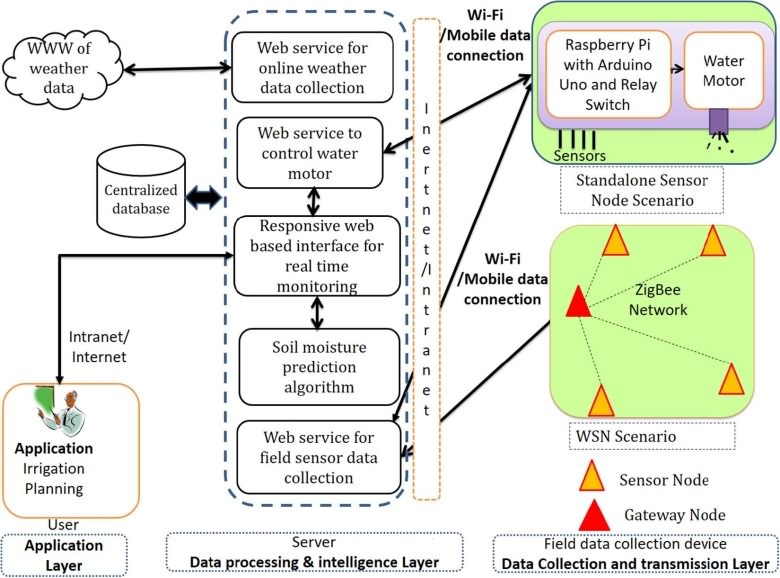इंटरनेट ऑफ थिंग्स आधारित स्मार्ट सिंचाई शेड्यूलिंग प्रणाली
The scarcity of clean water resources around the globe has generated a need for their optimum utilization.Internet of Things (IoT) solutions, based on the application specific sensors’ data acquisition and intelligentprocessing, are bridging the gaps between the cyber and physical worlds. IoT based smart irrigation managementsystems can help in achieving optimum water-resource utilization in the precision farming.
Why should we go for irrigation scheduling smartly?
Water scarcity is already affecting a part of the world and the situation is getting worse over time due to the increasing world population and fresh water demands. The current world population is around 7.2 billion and it is expected to be more than 9 billion by 2050. The agriculture sector, particularly irrigation, consumes a major portion of the freshwater.
Due to lack of cost-effective intelligent irrigation systems, developing countries are consuming more water in contrast to the developed countries for achieving the same yield. For example, India has approximately 4% of world’s freshwater resources to serve 17% of the world population; however, it takes 2–4 times more water for some of its major agri-produce in comparison to the other countries like China, USA.
Therefore, there is a dire need to come up with advanced technologies based on smart strategies and systems for effective utilization of fresh water. Figure 1 shows the comparative efficiency of various irrigation techniques practiced in farmland.

Fig.1 Various irrigation techniques and their efficiencies
What is IoT?
The term “IoT” stands for the internet of things, can be defined as the interconnection between the individually identifiable embedded computing apparatus in the accessible internet infrastructure. The ‘IoT’ connects various devices or equipment and transportations with an help of internet as well as electronic sensors.
Components of IoT based smart irrigation system
The architecture of proposed IoT based smart irrigation system is shown in Fig. 2. It has seven main components, viz., Field data collection device with relay switch (Standalone and WSN Scenario); Web service for collecting field sensor data; Web service for collecting weather information available online (Internet); Web service to control water motor; Soil moisture prediction algorithm; Responsive web based interface for real-time monitoring; IoT enabled motor pump
These components are grouped into three different layers, i.e. Data collection and transmission layer, Data processing & intelligence layer and application layer of IoT. The components are discussed one by one.

Fig. 2 Architecture of IoT based irrigation system
Field data collection device
Depending on the field requirements, a standalone sensor node or awireless sensor network of the sensor nodes may be deployed. Instandalone scenario field data collection device consists of four sensors,viz., Soil Moisture sensor, Soil temperature sensor, temperature and humidity sensor, and Ultraviolet (UV) Light Radiationsensor. The output ofthese sensors is read by an Arduino-Uno, which is connected toRaspberry Pi (R-Pi) for fetching and storing the data from sensors.
Web service for online weather data collection
A web service is developed to collect the weatherforecasting data. This web service also aggregates the weather forecastingdata like temperature, humidity, cloudiness, UV Index andprecipitation of different web forecasting portals. The developed web service read theforecasted data of the field location andstore in the server, which is considered in the soil moistureprediction algorithm.
Soil moisture prediction algorithm
An algorithm is developed to predict the soil moisture based on field sensors data and weather forecasting data using algorithms like support vector regression model and k-means clustering algorithm etc.
The algorithm shows information regarding soil moisture of the upcomingdays. It also provides irrigation suggestions, based on the defined levelof soil moisture and predicted precipitation, to save water and energy.
Responsive web based interface for real-time monitoring
A responsive web based user interface is developed to visualize real-timesensors data, predicted soil moisture of upcoming days, and precipitationinformation. Further, it also provides a facility for irrigationscheduling. The user can schedule the irrigation at a specified thresholdvalue of soil moisture.
Web service to control water motor
A web service is developed to startand stop the water motor. This web service is accessed byR-Pi to start and stop the water motor. The R-Pi send signal to Arduino-Uno that controls the relayswitch to start/stop the water motor.
IoT enabled water pump
In this module, a water pump is connected to a relay switch that iscontrolled by a Wi-Fi enabled node. The node is controlled by the webservice through a trigger from the responsive web based interface forreal-time monitoring. Using this web based interface the water pumpcan be managed remotely in manual and auto modes.
Advantages of IoT based smart irrigation system
The IoT based smart irrigation system avoids over use of water in irrigation, under irrigation and reduces the wastage of water and it can be implemented in large agricultural areas. The system can be a solution to labor shortage problem in agricultural. Irrigation in crops fields can be operated automatically as well as manually using this system.
Conclusions
Agriculture is the largest consumer of fresh water. At present scenario, due to increasing population, land and water resources are under enormous pressure which emphasis on sustainable use of natural resources. Hence, there is a need of inculcation of advanced technology like IoT based smart irrigation system. It provides a smart solution to full fill the more crop per drop motto of PMKSY.
This system uses information from soil moisture sensors to irrigate soil which helps to prevent over irrigation or under irrigation of soil as a result prevent crop damage. The farm owner can also monitor the process online through a website. IoT based smart irrigation system in the field of agriculture plays important role for enhancing water productivity as well as in reducing the extra man power efforts, fertilizer and water requirement.
Thus, this system is a potential solution to the problems faced in the existing manual and cumbersome process of irrigation by enabling efficient utilization of water resources and also minimized human intervention in farming activities.
Therefore, it provides the smart solution of water crisis as well as provide the automated system through which one farmer can control the large farm area located at different location by using their mobile from remote place and fulfill the requirement of “doubling the farmers’ incomes”.
Authors:
Akram Ahmed, ArtiKumari, Manibhushan, SurajitMondal and PawanJeet
ICAR Research Complex for Eastern Region, ICAR Parisar,
P. O.: Bihar Veterinary College, Patna, Bihar – 800014
*Email:
